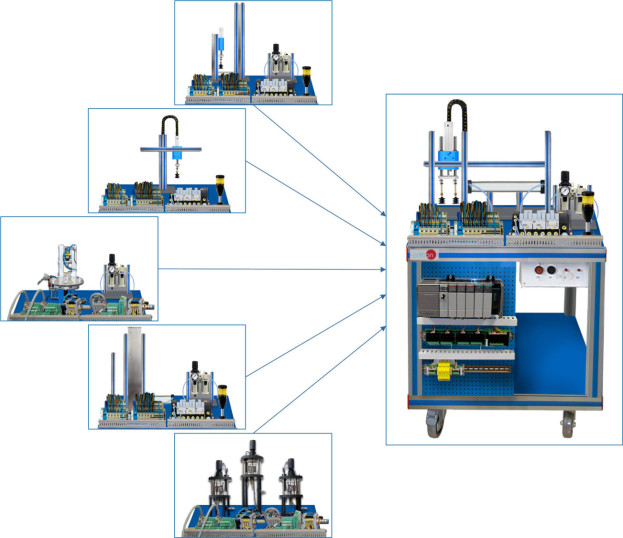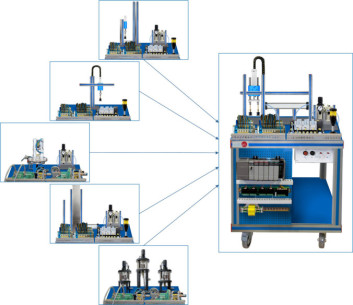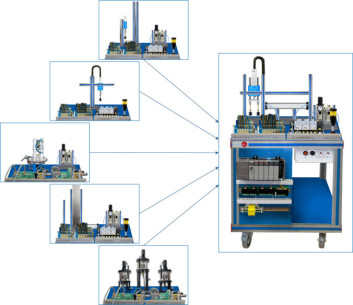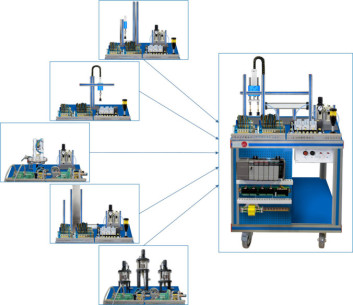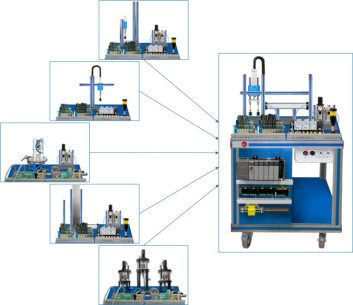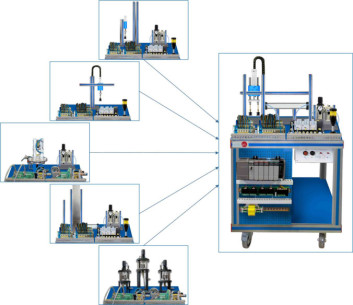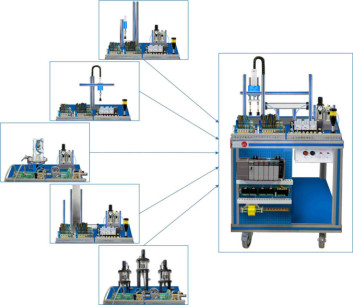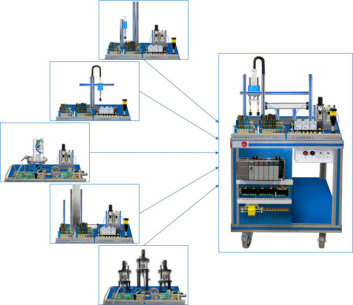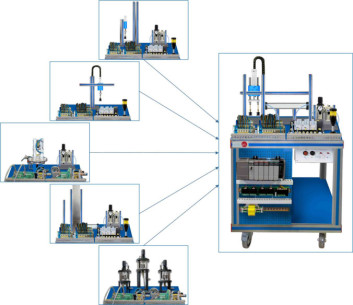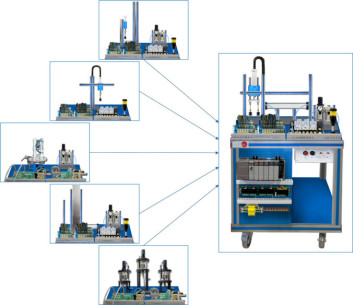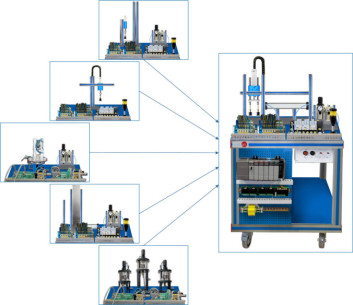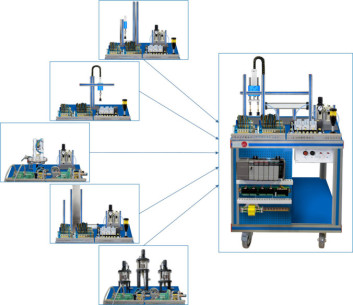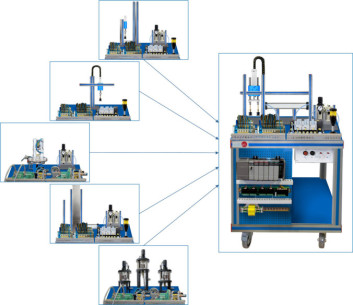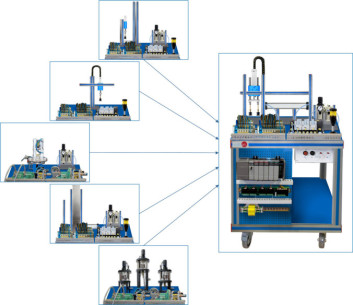At EDIBON, we are committed to strengthening skills as a strategic pillar for the competitiveness and social well-being of the European Union. Proper training not only boosts the economy but also enables individuals to fully participate in society and democracy.
AE-PLC-P Estação de Prensagem Automática
SISTEMAS INOVADORES
The "AE-PLC-P" workstation includes a set of practical exercises through which the student will understand how to control an automatic pressing system with a pneumatic handling system.
NOTÍCIAS RELACIONADAS
Descrição Geral
The "AE-PLC-P" is an automatic pressing workstation commanded by a PLC. The "AE-PLC-P" moves the pieces from the input zone tothe pressing zone, once the piece is detected in the pressing zone, the "AE-PLC-P" emulates pressing the pieces with a hydraulic actuator.
The "AE-PLC-P" workstation is designed as a modular system to facilitate the understanding of the unit. The main components are:
- The PLC: is composed by the CPU limit and all extra modules needed to perform a corrent working of the workstation and all the extramodules needed to perform a correct working of the workstation.
- The control panel: with start/stop button, emergency pushbutton, reset button, light indicators to show current state of the process, etc.
- The pneumatic circuit: contains the required solenoid valves, the pressure components, the filters and regulators to assure the appropriate working of the unit.
- The Hydraulic circuit: contains the required solenoid valves, actuators, filters and regulators to assure the appropriate working of the unit.
- The workstation: is composed by real industrial components used by the industrial pressing systems with pneumatic manipulator suchas reed sensors, presence sensors, rotary actuators, vacuum cups, etc.
The "AE-PLC-P" is an independent workstation that can work alone and/or in conjunction with other workstation to make up a complete Flexible Manufacturing system*.
*The Flexible manufacturing systems product list is available at "Flexible Manufacturing Systems (FMS)" area of the general catalogue.
EXERCÍCIOS E PRÁTICAS GUIADAS
EXERCÍCIOS PRÁTICOS GUIADOS INCLUÍDOS NO MANUAL
- Introduction to flexible manufacturing system (FMS).
- Introduction to pneumatics and electro-pneumatics.
- Introduction to hydraulics and electro-hydraulics.
- Introduction to vacuum technology.
- Study of the sensor detection.
- Configuration of a pneumatic application.
- Configuration of a hydraulic application.
- Manual control of a Pressing system.
- Automatic control of a Pressing system.
- Change the parameters of the Pressing process.
- Optimization of the process time.
- Study and analysis of the faults inserted in the process with the fault generation module.
EQUIPAMENTOS SIMILARES DISPONÍVEIS
6.2.5.2.- APLICAÇÕES DE ESTAÇÕES DE TRABALHO DE PROCESSOS
AE-PLC-FT
The "AE-PLC-FT" is a filtration system commanded by a PLC. The "AE-PLC-FT" is composed of two tanks with a filter between them. The liquids are pumped from the first tank into the second tank through the filter using a pump and different types of...
6.2.5.2.- APLICAÇÕES DE ESTAÇÕES DE TRABALHO DE PROCESSOS
AE-PLC-MS
Estação de Mistura
The "AE-PLC-MS" is a mixing system commanded by a PLC. The "AE-PLC-MS" is composed of three tanks with different liquids. These liquids are pumped and mixed in a reactor vessel using a pump and different valves. The system is equipped with flow...
6.2.5.2.- APLICAÇÕES DE ESTAÇÕES DE TRABALHO DE PROCESSOS
AE-PLC-PHD
Estação de Perfuração
The "AE-PLC-PHD" is a processing workstation commanded by a PLC. This unit takes a piece and introduces it inside the punching zone that is protected with a polycarbonate screen. Once the piece is inside the punching zone, the hydraulic punching...
6.2.5.2.- APLICAÇÕES DE ESTAÇÕES DE TRABALHO DE PROCESSOS
AE-PLC-FS
Estação de Enchimento
The "AE-PLC-FS" is a filling system commanded by a PLC. The workstation detects the bottles that arrive on a conveyor belt to the filling position and pumps liquids from a reservoir tank into the bottles using a pump and different types of valves....
6.2.5.2.- APLICAÇÕES DE ESTAÇÕES DE TRABALHO DE PROCESSOS
AE-PLC-CRS
Estação de Aplicação de Rolha
The "AE-PLC-CRS" is a corking system commanded by a PLC. The workstation detects the bottles that arrives on a conveyor belt to the corking position and closes them with a cap using a pressing cylinder. The "AE-PLC-CRS" also includes different...
6.2.5.2.- APLICAÇÕES DE ESTAÇÕES DE TRABALHO DE PROCESSOS
AE-PLC-APB
Estação de Abertura de Garrafas
The "AE-PLC-APB" is a bottles opening system commanded by a PLC. The unit is equipped with different containers and a retention system based on a cylinder, in order to allow the Robotic Arm Workstation "AE-BR" or the SCARA Arm Workstation "AE-SCA"...
6.2.5.2.- APLICAÇÕES DE ESTAÇÕES DE TRABALHO DE PROCESSOS
AE-PLC-M
Estação de Montagem
The "AE-PLC-M" is a mounting workstation commanded by a PLC that provides pieces to the system and mount them inside of the base pieces.The "AE-PLC-M" keeps the pieces in a vertical storage. The workstation take the pieces one by one, the quality...
6.2.5.2.- APLICAÇÕES DE ESTAÇÕES DE TRABALHO DE PROCESSOS
AE-PLC-AT
Estação Parafusadeira Automática
The "AE-PLC-AT" is an automatic screw workstation commanded by a PLC that supply and mount four screws in a piece. The "AE-PLC-AT" keeps the screws in a vertical storage. The workstation take the screws, one by one, and a pneumatic manipulator...
6.2.5.2.- APLICAÇÕES DE ESTAÇÕES DE TRABALHO DE PROCESSOS
AE-PLC-MEMB
Estação de Envasamento
The "AE-PLC-MEMB" is a bottling workstation commanded by a PLC that provides pieces to the system and mount them inside of the base pieces.The "AE-PLC-MEMB" transport the input bottles, to the filling area. In this zone, the "AE-PLC-MEMB" fills...
6.2.5.2.- APLICAÇÕES DE ESTAÇÕES DE TRABALHO DE PROCESSOS
AE-PLC-MET
Estação de Etiquetagem
The "AE-PLC-MET" is an automatic labelling machine commanded by a PLC. The "AE-PLC-MET" also include a transporting system that carries the incoming bottles to the labelling zone, supplying the bottles one by one.The "AE-PLC-MET" workstation is...
6.2.5.2.- APLICAÇÕES DE ESTAÇÕES DE TRABALHO DE PROCESSOS
AE-PLC-ST
Estação de Furação
The "AE-PLC-ST" is an automatic drilling workstation commanded by a PLC. The "AE-PLC-ST" also include a conveyor system to transport the incoming pieces to the drilling zone where the drilling machine simulate the process.The "AE-PLC-ST"...
6.2.5.2.- APLICAÇÕES DE ESTAÇÕES DE TRABALHO DE PROCESSOS
AE-PLC-SMOLD
Estação de Moldagem
The "AE-PLC-SMOLD" is an automatic molding workstation commanded by a PLC. The "AE-PLC-SMOLD" also include a conveyor system to transport the incoming pieces to the molding zone where the unit simulate a molding process by punching the piece with...
6.2.5.2.- APLICAÇÕES DE ESTAÇÕES DE TRABALHO DE PROCESSOS
AE-PLC-SCOR
Estação de Corte
The "AE-PLC-SCOR" is an automatic cutting workstation commanded by a PLC. The "AE-PLC-SCOR" also includes a conveyor system to transport the incoming pieces to the cutting zone where the cutting machine simulate the process.The "AE-PLC-SCOR"...
6.2.5.2.- APLICAÇÕES DE ESTAÇÕES DE TRABALHO DE PROCESSOS
AE-PLC-CP
Estação de Controle de Processos
The "AE-PLC-CP" is a process control workstation commanded by a PLC that coordinates the work of 3 industrial controllers that regulates in parallel the level, flow rate, temperature and pressure processes. The "AE-PLC-CP" workstation has been...
EQUIPAMENTOS COMPLEMENTARES
6.2.5.2.- APLICAÇÕES DE ESTAÇÕES DE TRABALHO DE PROCESSOS
AE-PLC-M
Estação de Montagem
The "AE-PLC-M" is a mounting workstation commanded by a PLC that provides pieces to the system and mount them inside of the base pieces.The "AE-PLC-M" keeps the pieces in a vertical storage. The workstation take the pieces one by one, the quality...
6.2.5.2.- APLICAÇÕES DE ESTAÇÕES DE TRABALHO DE PROCESSOS
AE-PLC-AT
Estação Parafusadeira Automática
The "AE-PLC-AT" is an automatic screw workstation commanded by a PLC that supply and mount four screws in a piece. The "AE-PLC-AT" keeps the screws in a vertical storage. The workstation take the screws, one by one, and a pneumatic manipulator...
6.2.5.2.- APLICAÇÕES DE ESTAÇÕES DE TRABALHO DE PROCESSOS
AE-PLC-MEMB
Estação de Envasamento
The "AE-PLC-MEMB" is a bottling workstation commanded by a PLC that provides pieces to the system and mount them inside of the base pieces.The "AE-PLC-MEMB" transport the input bottles, to the filling area. In this zone, the "AE-PLC-MEMB" fills...
6.2.5.2.- APLICAÇÕES DE ESTAÇÕES DE TRABALHO DE PROCESSOS
AE-PLC-MET
Estação de Etiquetagem
The "AE-PLC-MET" is an automatic labelling machine commanded by a PLC. The "AE-PLC-MET" also include a transporting system that carries the incoming bottles to the labelling zone, supplying the bottles one by one.The "AE-PLC-MET" workstation is...
6.2.5.2.- APLICAÇÕES DE ESTAÇÕES DE TRABALHO DE PROCESSOS
AE-PLC-ST
Estação de Furação
The "AE-PLC-ST" is an automatic drilling workstation commanded by a PLC. The "AE-PLC-ST" also include a conveyor system to transport the incoming pieces to the drilling zone where the drilling machine simulate the process.The "AE-PLC-ST"...
6.2.5.2.- APLICAÇÕES DE ESTAÇÕES DE TRABALHO DE PROCESSOS
AE-PLC-SMOLD
Estação de Moldagem
The "AE-PLC-SMOLD" is an automatic molding workstation commanded by a PLC. The "AE-PLC-SMOLD" also include a conveyor system to transport the incoming pieces to the molding zone where the unit simulate a molding process by punching the piece with...
6.2.5.2.- APLICAÇÕES DE ESTAÇÕES DE TRABALHO DE PROCESSOS
AE-PLC-SCOR
Estação de Corte
The "AE-PLC-SCOR" is an automatic cutting workstation commanded by a PLC. The "AE-PLC-SCOR" also includes a conveyor system to transport the incoming pieces to the cutting zone where the cutting machine simulate the process.The "AE-PLC-SCOR"...
6.2.5.2.- APLICAÇÕES DE ESTAÇÕES DE TRABALHO DE PROCESSOS
AE-PLC-FT
Estação de Filtragem
The "AE-PLC-FT" is a filtration system commanded by a PLC. The "AE-PLC-FT" is composed of two tanks with a filter between them. The liquids are pumped from the first tank into the second tank through the filter using a pump and different types of...
6.2.5.2.- APLICAÇÕES DE ESTAÇÕES DE TRABALHO DE PROCESSOS
AE-PLC-MS
Estação de Mistura
The "AE-PLC-MS" is a mixing system commanded by a PLC. The "AE-PLC-MS" is composed of three tanks with different liquids. These liquids are pumped and mixed in a reactor vessel using a pump and different valves. The system is equipped with flow...
6.2.5.2.- APLICAÇÕES DE ESTAÇÕES DE TRABALHO DE PROCESSOS
AE-PLC-PHD
Estação de Perfuração
The "AE-PLC-PHD" is a processing workstation commanded by a PLC. This unit takes a piece and introduces it inside the punching zone that is protected with a polycarbonate screen. Once the piece is inside the punching zone, the hydraulic punching...
6.2.5.2.- APLICAÇÕES DE ESTAÇÕES DE TRABALHO DE PROCESSOS
AE-PLC-FS
Estação de Enchimento
The "AE-PLC-FS" is a filling system commanded by a PLC. The workstation detects the bottles that arrive on a conveyor belt to the filling position and pumps liquids from a reservoir tank into the bottles using a pump and different types of valves....
6.2.5.2.- APLICAÇÕES DE ESTAÇÕES DE TRABALHO DE PROCESSOS
AE-PLC-CRS
Estação de Aplicação de Rolha
The "AE-PLC-CRS" is a corking system commanded by a PLC. The workstation detects the bottles that arrives on a conveyor belt to the corking position and closes them with a cap using a pressing cylinder. The "AE-PLC-CRS" also includes different...
Qualidade

Serviço pós-venda

 Preferências de cookies
Preferências de cookies

